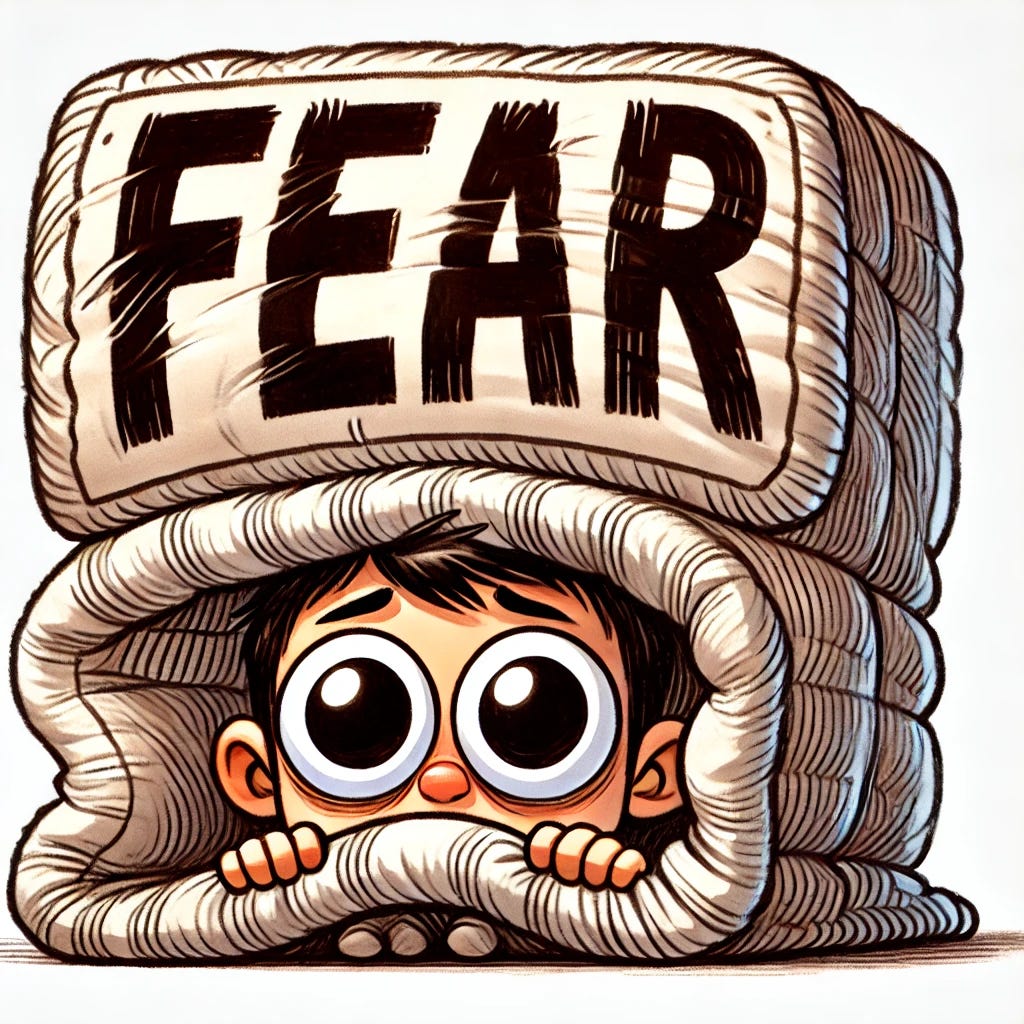10X Writer #08
Welcome to 10X Writer, the weekly newsletter designed to help writers, copywriters, and freelancers achieve 10X results with expert insights and actionable strategies.
Subscribe now to get future posts.
Introduction
Why do we make the decisions we do?
You might think you’ve got a handle on it. "I’m a logical person," you tell yourself. But if we’re really honest, most of our decisions come from a much deeper place—our emotions.
It’s like picking a dessert. You might have a health-conscious angel on one shoulder, whispering all the facts about sugar, calories, and long-term health. But what do you do? You grab the chocolate cake anyway because it just feels right. That’s the power of emotions.
That’s why understanding emotions is a superpower. It helps you connect with your audience in ways logic never could. Using emotional triggers isn't about manipulating people into doing what you want. It’s about understanding what drives them and helping them feel that your product or service fits right into their world.
So, let’s learn how emotions drive decisions and how you can tap into those emotions without sounding like a sleazy used-car salesman.
How Emotions Really Drive Decisions
Imagine you’re standing in a shop, looking at two phones.
One is packed with features—high megapixels and a fancy list of benefits as long as your arm—while the other just looks good. You pick it up, it feels sleek, and suddenly, you imagine yourself casually checking Instagram while waiting for your coffee.
Which phone are you buying?
Yep, it’s not the one with the mind-numbing spec sheet. It’s the one that made you feel something. That’s because our brains are wired to make decisions emotionally and then justify them logically afterward.
Neuroscientist Antonio Damasio proved this point when he found that people with damaged emotional centers in their brains struggled to make even the simplest decisions. They had all the logic in the world, but without emotion to guide them, they were stuck in analysis paralysis.
And here’s where it gets exciting for us copywriters.
When you tap into the emotions that drive your audience—fear, desire, empathy, or trust—you connect with them on a deeper level. The logical part of the brain takes a backseat, and the decision-making process gets supercharged.
But remember, this isn’t about manipulation. It’s about understanding what moves your audience and meeting them there.
Six Emotional Triggers That Really Get People to Move
Now, you might be wondering, “Okay, I get it—emotions are powerful. But which ones should I use?”
Well, here’s the fun part. Different emotions trigger different actions. Let’s explore a few of the big hitters.
Fear
Fear is like a fire alarm. When it goes off, you drop everything and pay attention.
It’s the most primal of all emotions, hardwired into our survival instincts. In copy, fear creates urgency. Fear of missing out (FOMO), fear of loss, or even fear of danger can push your audience to act fast.
But let’s be real here: too much fear can backfire. Ever seen those scare-tactic insurance ads? They leave you feeling anxious. Fear works best when you offer a clear, soothing solution.
You can trigger fear, but calm it down by showing how your product solves the problem.
Desire
Desire is the shiny apple on the tree. It’s the thing your audience wants.
They don’t just want to feel safe. They want to feel like they’re winning at life. Desire taps into their dreams—whether that’s a better body, a dream vacation, or simply feeling more confident.
Fitness programs nail this every time. They’re not just selling workouts. They’re selling the dream of a fitter, stronger, more fabulous version of you.
It’s all about what could be, not what is.
Empathy
Empathy is your “I get it” button.
When your audience feels like you understand them, you’re no longer a company selling stuff. You’re a friend who gets their pain and offers relief. And that’s powerful.
Let’s take a meditation app. It’s not about saying, “Here’s an app.” It’s about saying, “I know how chaotic and stressful your life can get. This is the calm you’ve been searching for.”
When you show empathy, people trust you because they feel understood.
Trust
Trust takes time. You can’t build it with just one ad or one email, but it’s essential for long-term relationships.
If you’re in B2B marketing or selling a high-ticket product, trust is your go-to emotion. Use testimonials, guarantees, and crystal-clear messaging to build it.
Think of trust as a good friendship. You won’t lend your friends money if you’ve only met them once. But after they’ve proven themselves over time? You’d trust them with your wallet.
Belonging
Humans are tribal by nature.
We all want to belong to something bigger than ourselves—a community, a movement, or a lifestyle. When your copy taps into this emotion, your audience feels like they’re joining a group of like-minded people who share their values.
Take Lululemon. Sure, they sell yoga pants, but what they’re really offering is a membership to a tribe of people who value fitness and wellness.
Belonging is about more than just buying a product—it’s about becoming part of something.
Happiness
And finally, there’s happiness. Everyone loves to feel good.
When your copy sparks joy, laughter, or even a sense of relief, it creates a bond between you and your audience. Coca-Cola’s “Open Happiness” campaign didn’t just sell soda. It sold happiness in a bottle. That’s the power of positive emotions.
How to Choose the Right Emotional Trigger
So you’re probably wondering, “Which emotion do I go with?” And the answer isn’t as simple as picking a card from a deck.
It all depends on what problem your product solves and, more importantly, how your audience feels at that moment.
Here’s a cheat sheet:
Fear
Suppose your product solves a pressing issue—security, health, or finances. Fear works like a fire alarm—it jolts people into action.
But here’s the kicker: you can’t just leave them panicking. Think about it. If your house were on fire and the alarm went off, you wouldn’t just sit there listening to the screeching sound, right? You’d need a way out. So yes, use fear to create urgency, but always follow it with a clear path to safety.
Whether that’s a security system, a medical solution, or a financial fix, make sure your audience knows you’ve got their back.
Desire
If your product promises transformation—something aspirational—then desire is your go-to emotion.
Think about luxury cars, fitness programs, or even entrepreneurial success. You’re not just selling a product. You’re selling a better version of your audience’s future selves. They don’t want a new car—they want the feeling of driving something sleek and powerful. They don’t just want a workout routine—they want to feel stronger, fitter, and more confident.
Desire pushes people toward that glittering vision of who they could be. Paint that picture and watch them lean in.
Empathy
We’ve all been there—feeling stressed, overwhelmed, or downright stuck. If your product offers a solution to an emotional pain point like stress, loneliness, or anxiety, empathy is your secret weapon.
Think of it as extending a hand to someone who’s drowning. You’re not just offering a product; you’re offering understanding. When your audience feels like you “get” them, they’re more likely to trust you. And that trust? It’s the first step toward a deeper relationship where they see your product as the answer to their unspoken struggles.
Trust
Trust isn’t built overnight. It’s like a bank account—you make deposits over time, and eventually, your audience will trust you with their biggest financial decisions.
High-ticket items? Long-term commitments? Trust is non-negotiable here.
Testimonials, guarantees, and straightforward communication are your tools. It’s like asking someone to hold your wallet while you take a dip in the pool. There’s no way you’re handing it over unless you really trust them, right?
In the same way, your audience won’t commit unless they’re confident you’ll deliver on your promises.
Belonging
We all have that deep-rooted need to belong.
It’s why people join clubs, wear branded clothing, or align themselves with certain movements. If your product is about building a community—whether a lifestyle brand or a cause—tap into that sense of belonging. Make your audience feel like they’re becoming part of something special, something bigger than themselves.
Lululemon doesn’t just sell yoga pants. They sell a tribe of fitness enthusiasts. And when you make your audience feel like they’re missing out on being part of that tribe? They’re far more likely to join.
Happiness
Happiness is one of the most irresistible emotions out there.
It’s what we’re all chasing—whether through small pleasures like a delicious meal or larger joys like a family vacation. If your product is about joy, satisfaction, or simply improving life, happiness is the emotion you want to evoke. Focus on how your product brings a smile to your audience’s face, and they’ll be more than happy to buy in.
How to Write Copy That Makes Your Audience Feel Something
Now that you know which emotions to tap into, the question is: how do you actually write copy that makes your audience feel something?
It’s easier than you think.
Start with the emotion, not the product:
Forget about the features for a minute. Ask yourself, “How do I want my audience to feel when they read this?” Then, start by painting a picture of that emotion. Only once you’ve hooked them emotionally should you start talking about your product.
Tell a story:
Stories are like little emotion delivery systems. They bring abstract ideas to life in a way that stats and facts can’t. Want to sell a product that relieves stress? Don’t just list the benefits. Tell a story of someone who was overwhelmed and found peace using your product.
Use sensory language:
Emotions are tied to our senses, so make your copy come alive with sensory details. Don’t just tell them about the product. Make them feel it. Imagine describing a spa service. Instead of saying, “It’s relaxing,” try, “Feel the tension melt away as soothing music and warm towels surround you.”
Wrap your CTA in emotion:
Don’t just say, “Buy Now.” If you’ve been building up desire, say, “Claim the confidence you deserve today.” If you’ve been focusing on trust, say, “Take the first step toward financial freedom.” These subtle emotional touches in the CTA make the action feel like a natural next step.
Balance emotion with logic:
Yes, emotions drive decisions, but people also need to feel like they’re making a smart choice. Use testimonials, guarantees, or data to back up your emotional appeal and reassure them that they’re making the right decision.
The Four Pitfalls You Must Avoid When Using Emotional Triggers
Before we wrap up, let’s talk about a few common mistakes. Emotional triggers are powerful but can also backfire if you’re not careful.
Too much emotion:
Ever had someone come on way too strong, way too fast? It’s uncomfortable, right? The same thing happens in copy. Lay on too much emotion, and you might push people away. Imagine reading a donation request that keeps pounding you with guilt—it’s exhausting.
Instead, use emotional language like a spice: enough to add flavor but not so much that it overpowers the dish.
Inauthentic emotions:
We’ve all seen those ads that go way over the top, trying to pull heartstrings with overblown emotional appeals. People aren’t naive. They can spot manipulation from a mile away. Your audience will disengage if your emotional triggers don’t feel genuine or grounded in reality.
Keep it real. If you’re talking about stress relief, be honest about it. Don’t exaggerate. Connect with what your audience is feeling and offer a sincere solution.
Choosing the wrong emotion:
Not all emotions fit every situation. Imagine using a fear-based message on someone who’s just looking for a fun new hobby. They’ll back away fast. Know your audience’s emotional state. If they’re already stressed, using fear might overwhelm them. But if they feel optimistic, a message that focuses on happiness and desire will resonate better. Meet them where they are emotionally.
Inconsistent messaging:
Your emotional triggers need to align with your brand tone and message. If your brand is known for positivity and inspiration, suddenly hitting people with fear can feel jarring and out of place. Consistency is key to building trust. Emotional triggers should reflect the overall experience you want to create for your audience. Stick with what feels right for your brand.
Conclusion
Emotions are the secret sauce of copywriting. They’re the reason why people act, why they buy, and why they stick around. When you understand which emotions drive your audience and how to tap into them authentically, your copy transforms from words on a page into a powerful connection tool.
But here’s the thing.
Emotional copywriting isn’t just about driving sales. It’s about building relationships. It’s about showing your audience that you get them, are there for them, and have exactly what they need.
So, next time you write, don’t just focus on the product.
Think about the emotions behind the purchase and use those to guide your copy. When you do, you’ll not only see better conversions but also build lasting connections that turn readers into loyal customers.
Three Ways You Can Help This Newsletter Thrive
Share Your Ideas: Do you have a topic you'd love to see in the next edition? I’m always looking for fresh ideas. Comment your suggestions, and let’s make this newsletter even more valuable together.
Spread the Word: Do you know someone who would appreciate this content? Share it with your friends. Your help is essential to growing this newsletter.
Engage: If you enjoyed this edition, don’t forget to like, comment, and restack it! Your engagement helps more people discover the newsletter and keeps the momentum going.









